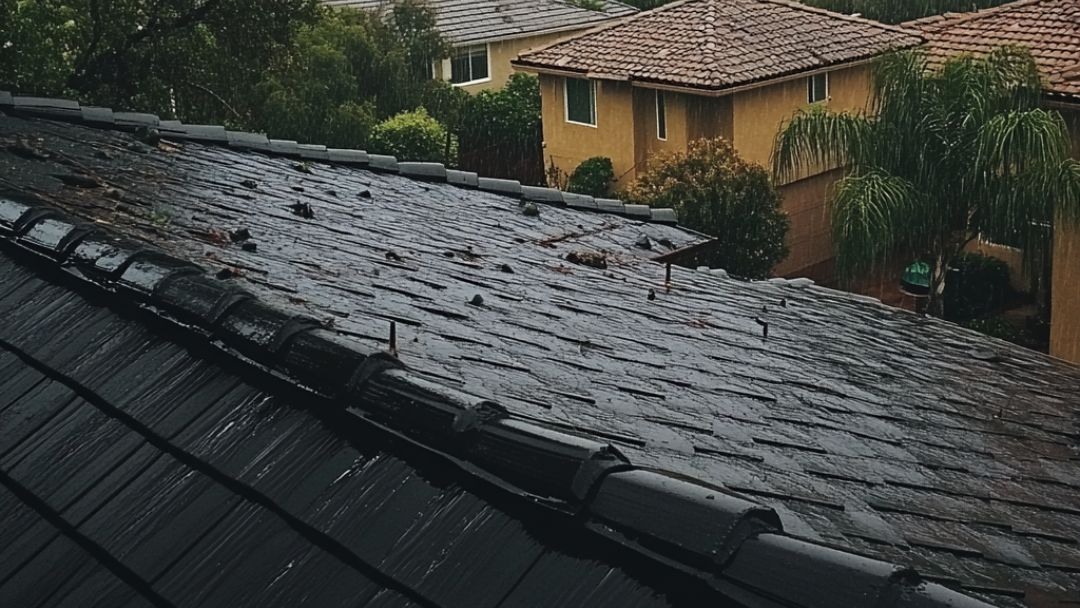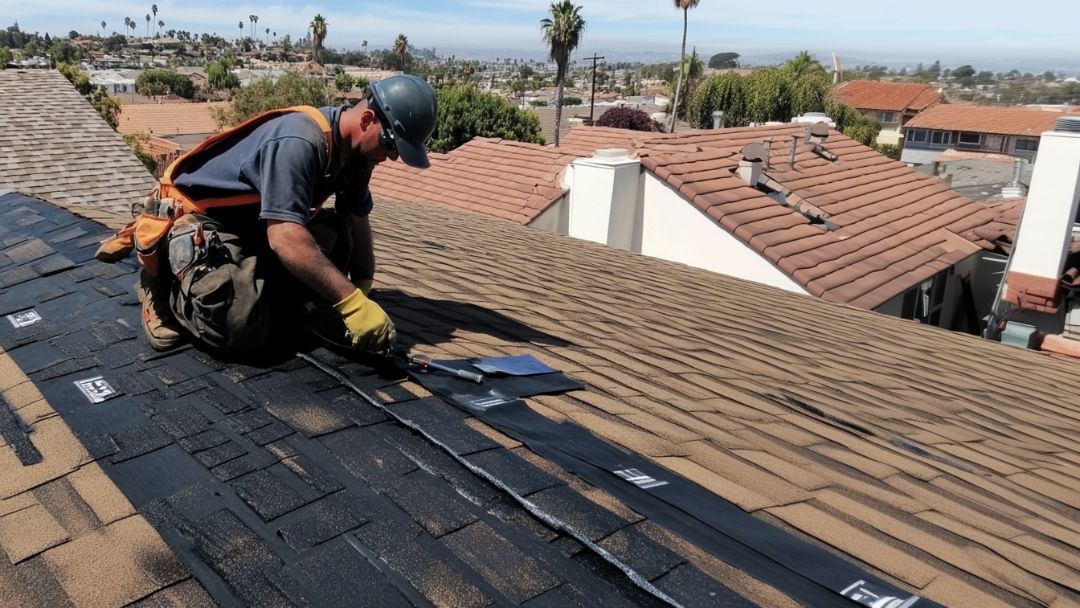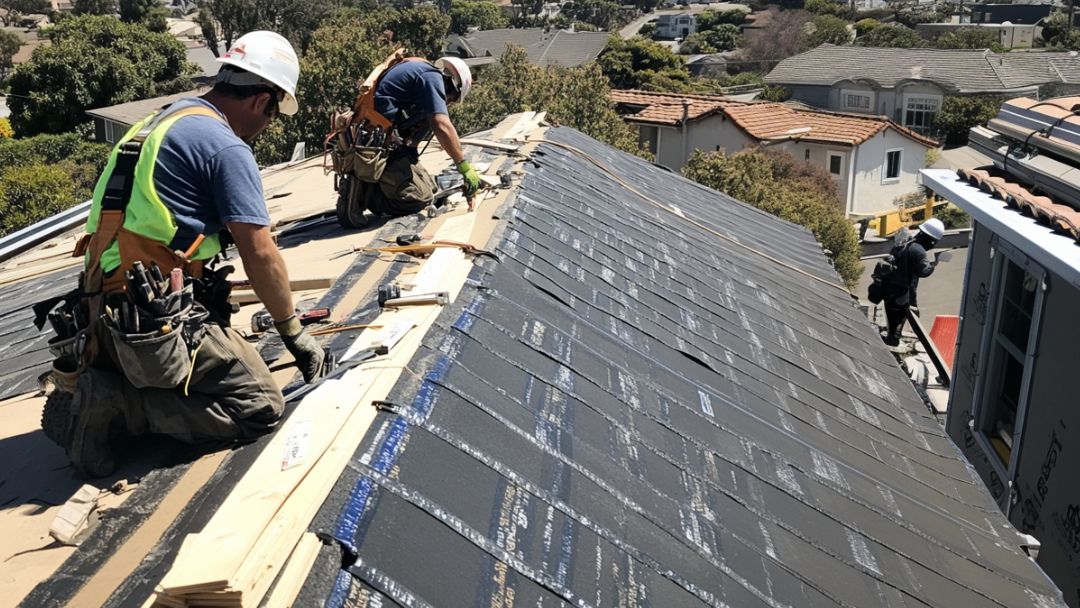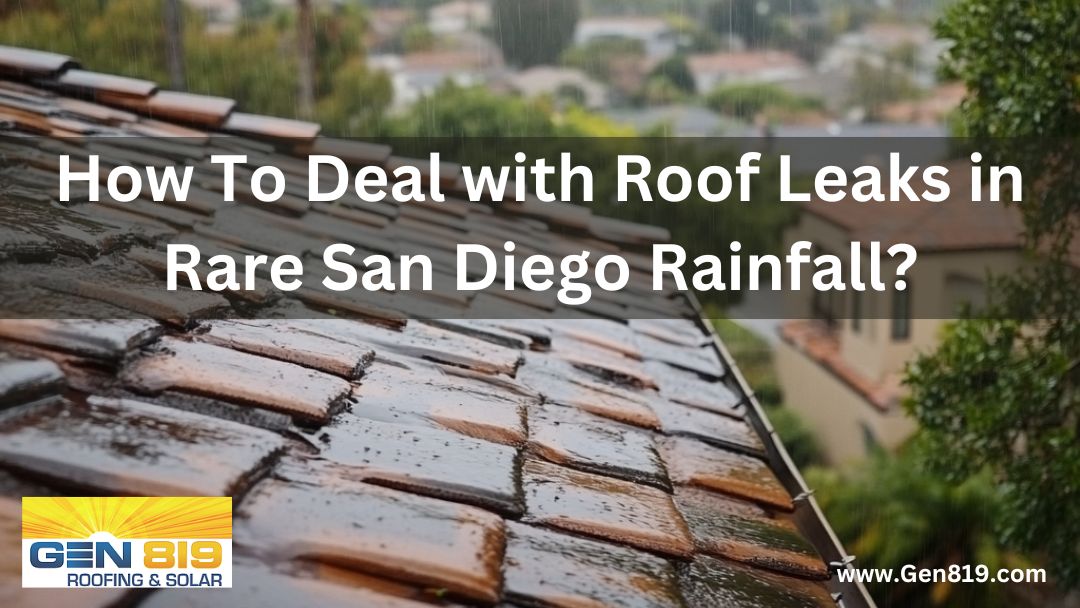Mon - Fr 9:00 am - 5:30 pm
3760 Oceanic Way STE 501, Oceanside, CA 92056
Posted by Gen819 Comments Off on How To Deal with Roof Leaks in Rare San Diego Rainfall Residential Roofing
How To Deal with Roof Leaks in Rare San Diego Rainfall
San Diego may be known for its sunny, mild weather, but when rain does hit, it can bring unexpected challenges for homeowners—especially when it comes to roof leaks. While frequent rainfall isn’t a concern here, the rare heavy downpours can expose vulnerabilities in roofs that go unnoticed in drier months. Constant sun exposure and the lack of routine moisture can weaken roofing materials, making them more prone to cracks, gaps, and other issues that lead to leaks.
For San Diego residents, the consequences of even a small roof leak can be significant, from water damage and mold growth to costly repairs and potential health risks. Because of this, proactive roof maintenance and quick action during those rare rainstorms are crucial to avoid bigger issues down the road. This guide will walk you through the common causes of roof leaks, how to recognize early warning signs, and simple preventive measures you can take to keep your home safe and dry. By understanding the unique roofing needs in San Diego’s climate, you’ll be better equipped to protect your investment and keep your home leak-free, rain or shine.
1. Why Roof Leaks Can Be Especially Problematic in San Diego
The Impact of Sun Exposure on Roofing Materials
San Diego’s warm, sunny climate brings benefits, but it also puts extra strain on roofs. With nearly constant sun exposure and high UV levels, roofing materials like shingles and tiles can dry out, crack, and weaken over time. Unlike in regions with regular rainfall, this gradual wear often goes unnoticed, leaving roofs more susceptible to damage when the rain does come.
The Risk of Rare but Intense Rainfalls
When rain finally hits San Diego, it often arrives in intense bursts. These heavy downpours can exploit small vulnerabilities in the roof, such as minor cracks or worn seals around chimneys, vents, and skylights. With limited rain throughout the year, these minor issues may be missed during routine maintenance, causing sudden leaks that lead to costly water damage.
Debris Buildup from Extended Dry Periods
Extended dry spells also contribute to debris accumulation in gutters and drainage systems, which can block proper water flow during a storm. In a single rainfall, pooled water can put added pressure on the roof and lead to leaks or structural strain. By understanding these climate-specific risks, San Diego homeowners can better prepare their roofs for unpredictable weather events, reducing the risk of damage.
2. Common Causes of Roof Leaks in San Diego
Roof leaks can be especially problematic in San Diego due to the unique local climate. Here are the main causes and how they’re influenced by the environment.
1. Cracked or Broken Shingles and Tiles
San Diego’s constant sun exposure can dry out roofing materials like shingles and tiles, causing them to crack and weaken over time. Asphalt shingles and clay tiles are particularly susceptible to UV damage, leading to brittleness. While these small cracks might go unnoticed in dry conditions, they can quickly allow water in during a rainstorm, causing leaks that damage the interior.
2. Compromised Roof Flashing
Roof flashing, typically made of metal, seals areas around openings like chimneys, skylights, and vents. Prolonged heat can warp flashing or weaken its seals, creating gaps. Since San Diego doesn’t experience frequent rain, these issues can go undetected, only to become serious leaks when heavy rain finally arrives.
3. Clogged Gutters and Downspouts
San Diego’s dry climate often leads to neglected gutters, where dust, leaves, and branches can accumulate. When rain does hit, clogged gutters can’t drain properly, leading to water pooling on the roof. This pooled water adds pressure to weak points, increasing the likelihood of leaks and internal damage.
4. Aging Roofs and Lack of Routine Inspections
Without regular rain, small issues on older roofs often go unnoticed. Many homeowners in San Diego skip routine inspections, so minor cracks or worn areas accumulate over time. When a rare rainstorm hits, these weaknesses are suddenly exposed, resulting in leaks.
Understanding these common causes can help San Diego homeowners stay vigilant and conduct necessary maintenance to prevent costly leaks.

3. Signs of a Roof Leak During and After Rain
Visible Water Drips and Damp Spots
One of the most obvious signs of a roof leak is seeing water dripping from the ceiling or noticing damp spots forming on walls or ceilings. During or immediately after a rainstorm, check areas below the roofline for any water entry points. Even small drips can indicate a larger underlying issue that needs attention.
Discolored Ceilings and Walls
Water stains often appear as yellow or brown rings on the ceiling or walls, signaling moisture has seeped through. Even after the rain has stopped, these stains may persist, indicating a recurring issue that’s likely worsening over time. Dark stains or streaks could also mean there’s ongoing leakage that needs immediate investigation.
Musty or Damp Odors
Sometimes, leaks are not immediately visible but can be detected by a musty odor in the home. Moisture trapped within walls or attic spaces encourages mold and mildew growth, which produce a distinct smell. If you notice this odor, it’s a good idea to check your attic or upper rooms for hidden water damage.
Peeling Paint or Wallpaper
When moisture seeps into walls, it can cause paint and wallpaper to peel, bubble, or warp. This is a clear indication of water infiltration and can happen even with small, slow leaks. Monitoring any peeling or blistering paint can help you catch leaks early before they lead to more significant structural issues.
4. Immediate Steps to Take When You Notice a Leak
Contain the Water
As soon as you spot a leak, your first step should be to contain the water to prevent further damage to your floors, walls, or belongings. Place a bucket or container under the leak to catch dripping water. If the leak is splashing onto furniture or flooring, use towels around the area to absorb excess moisture and minimize spreading.
Protect Belongings and Remove Nearby Items
Move any valuable or sensitive items—like electronics, furniture, or rugs—away from the leak. Even a small amount of water can cause damage, so it’s important to clear the area to prevent further loss. If water has pooled on furniture or flooring, try to dry it quickly to avoid staining or mold growth.
Identify the Source (if possible)
Depending of the type of roof you have, it can be challenging to pinpoint the exact entry point of a leak during a rainstorm, it’s helpful to make a note of where water is entering. Look around chimneys, vents, and skylights, as these areas are common sources of leaks. Identifying the location of the leak can help professionals quickly target the area for repairs.
Mitigate Further Damage
If safe to do so, place a tarp or other waterproof material over the leak area on the roof to prevent more water from entering. Inside, use fans to help dry any affected areas, reducing the risk of mold growth.
Call a Roofing Professional
While these steps can minimize immediate damage, it’s essential to contact a roofing contractor as soon as possible. Roof leaks often signal underlying issues that need professional assessment to prevent further complications. By acting quickly, you can avoid more extensive repairs and protect your home’s integrity.
5. Preventive Maintenance to Avoid Future Leaks
Schedule Regular Roof Inspections
A yearly professional inspection can catch small issues—like loose shingles or worn flashing—before they escalate. Regular check-ups help you stay ahead of potential leaks, especially before the rainy season.
Check and Replace Damaged Shingles
Sun exposure and weathering can cause shingles to crack or come loose over time. Inspect your roof visually or have a roofer check for any damaged shingles. Promptly replacing damaged shingles can prevent water seepage and extend your roof’s life.
Clear Gutters and Downspouts
Clogged gutters lead to water pooling on the roof, increasing leak risks. Clear out leaves and debris at least twice a year to ensure water flows freely away from your roof, protecting it from unnecessary strain.
Inspect Flashing Around Roof Penetrations
Flashing around chimneys, vents, and skylights prevents water entry but can loosen or corrode over time. Check these areas regularly, resealing or replacing flashing if you notice gaps, rust, or wear.
Trim Overhanging Tree Branches
Branches that hang over your roof can scrape shingles and drop debris, clogging gutters. Trimming trees back reduces debris buildup and prevents branches from damaging your roof during wind.
Check Attics for Moisture
Inspect your attic for water stains or mold, as these can signal roof issues. Early detection allows you to address problems before they worsen, protecting your home’s interior.
These preventive steps can help reduce the risk of leaks and maintain your roof’s durability in San Diego’s climate.

6. Quick Roof Repairs Homeowners Can Handle (and When to Call a Pro)
Clean Gutters Regularly
One of the simplest but most effective repairs is keeping your gutters clear of debris. By ensuring water flows away from your roof, you reduce the risk of leaks and water damage. Homeowners can safely use a ladder to remove leaves, twigs, and dirt from gutters, especially before a storm.
Replace a Few Missing or Damaged Shingles
If you notice a shingle that’s cracked or missing, you may be able to replace it yourself if the area is easily accessible. Carefully lift surrounding shingles, remove the damaged one, and slide a new one into place. However, if you notice multiple missing shingles or damage in hard-to-reach areas, it’s best to contact a professional.
Seal Small Cracks and Leaks with Roofing Sealant
For minor leaks or cracks in areas like flashing or around vent pipes, a high-quality roofing sealant can be a quick fix. Apply a small amount over the crack or seam to create a temporary barrier against water entry. Keep in mind that this is only a short-term solution, and professional repairs may be needed for a more permanent fix.
When to Call a Professional Roofer
If the roof damage is extensive, or if you’re dealing with structural issues or leaks around complex areas like chimneys, skylights, or roof valleys, it’s time to call a roofing contractor. Professional roofers can handle repairs safely, prevent further damage, and ensure lasting protection for your home.
7. The Importance of Prompt Roof Repairs in San Diego
Addressing roof leaks as soon as they appear is essential, especially in San Diego’s climate. Even small leaks can lead to significant damage over time. When left unaddressed, water can seep into the structure of your home, weakening support beams and compromising insulation. Quick repairs prevent these costly structural issues, which can be far more expensive than a minor repair.
Another critical concern is mold and mildew. Moisture trapped in walls, ceilings, or attics creates an ideal environment for mold, which can spread quickly and pose serious health risks to your family. By fixing leaks promptly, you avoid the health hazards and potential expenses associated with mold remediation.
In addition to protecting your home and health, acting quickly on repairs can extend the lifespan of your roof. Damage left unattended often worsens with each rainstorm, potentially leading to a full roof replacement much sooner than expected. Ultimately, prompt repairs save you money, protect your investment, and help keep your home safe and comfortable, rain or shine.
8. When to Consider a Roof Replacement
In some cases, investing in a full roof replacement is more practical and cost-effective than continual repairs. If your roof is approaching or exceeding its typical lifespan—usually 20-30 years for asphalt shingles or 40-50 years for tile roofs—its materials may have worn down, making frequent repairs a temporary fix at best. An aging roof is more vulnerable to leaks, and patching up recurring issues can become costly over time.
Significant or widespread damage, such as multiple leaks, extensive shingle loss, or large sections with water damage, often signals that a replacement is more efficient. If leaks have caused structural issues, like rot in the decking or mold growth, a replacement ensures that these problems don’t compromise your home’s integrity.
Another consideration is energy efficiency. Older roofs often lack modern insulation benefits, meaning a new, energy-efficient roof can help reduce cooling costs in San Diego’s warm climate. While a replacement is a larger upfront investment, it provides a durable, long-term solution, saving you from the repeated expense and hassle of ongoing repairs while enhancing your home’s value and safety.

Contact A Local Roofing Professional To Get Help
Roof leaks, while often unexpected in San Diego’s dry climate, can lead to serious issues if left untreated. By understanding common causes, recognizing early warning signs, and taking immediate action, homeowners can protect their roofs from unnecessary damage. Preventive maintenance—such as regular inspections, clearing gutters, and checking flashing—goes a long way in safeguarding against leaks and extending the roof’s life. For minor issues, simple DIY repairs can help, but for larger or recurring problems, a professional roofing contractor is essential to ensure thorough, lasting solutions.
Whether it’s addressing a small leak or considering a full roof replacement, prompt, proactive care keeps your home secure and comfortable. If you’re experiencing roof issues or need expert advice, don’t hesitate to reach out to a professional local San Diego roofing contractor for an assessment and peace of mind.
Recent Posts
Attic Insulation Upgrades That Cut Cooling Costs
San Diego Roof Lifespans Explained
Do you have any questions?
Contact us at the Gen819 office nearest to you or submit a business inquiry online
Contact Us









